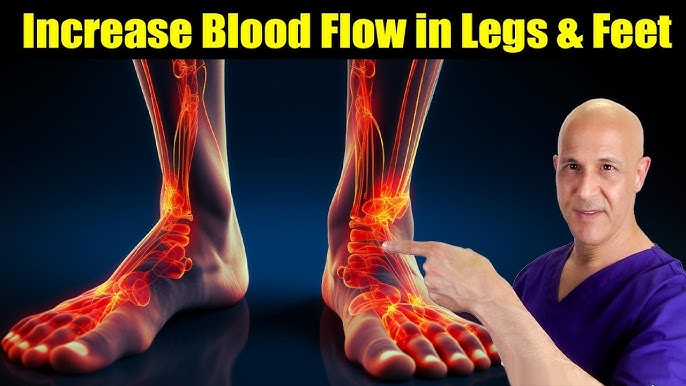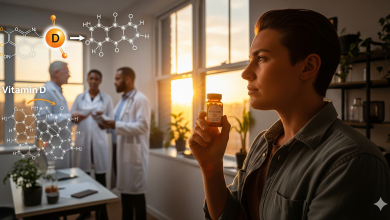Top 10 Vitamins for Circulation in Legs: Improve Blood Flow Naturally

Poor circulation in the legs is more common than many realize. It can cause symptoms like numbness, tingling, cold feet, cramps, and fatigue. Whether you sit for long hours, suffer from varicose veins, or have underlying conditions like diabetes or peripheral artery disease (PAD), improving blood flow in your legs is essential for overall health and mobility.
One of the best ways to naturally enhance circulation is through nutrition — specifically, vitamins and minerals that support healthy blood vessels and proper oxygen transport. The top 10 vitamins for circulation in legs and how they can help restore vitality to your lower limbs.
Understanding Leg Circulation
Before diving into the vitamins, let’s understand why leg circulation matters. Your circulatory system transports oxygen-rich blood from your heart to every part of your body. When blood flow slows — due to plaque buildup, inflammation, or vein issues — your legs often show the first signs.
Common Symptoms of Poor Leg Circulation
- Cold or numb feet and toes
- Tingling or “pins and needles” sensations
- Leg cramps, especially at night
- Swelling or heaviness in the calves
- Slow-healing wounds on the legs or feet
- Varicose or spider veins
If left untreated, poor circulation can lead to more serious complications, including chronic venous insufficiency or even blood clots. Fortunately, the right combination of vitamins and lifestyle changes can make a dramatic difference.
Top 10 Vitamins for Circulation in Legs
1. Vitamin E — The Antioxidant Powerhouse
Why It Helps:
Vitamin E is one of the most well-known nutrients for improving blood circulation. It helps prevent blood clots, reduces oxidative stress, and maintains the elasticity of blood vessels. Its natural blood-thinning effect ensures smoother blood flow through your arteries and veins.
Benefits for Legs:
- Prevents platelet clumping (reduces clot risk)
- Improves oxygen transport to muscles
- Supports healthy vein walls
Best Food Sources:
Almonds, sunflower seeds, spinach, avocados, and wheat germ oil.
Supplement Tip:
Look for natural d-alpha-tocopherol (the most bioavailable form) and take it with meals containing healthy fats for better absorption.
2. Vitamin C — Strengthens Blood Vessels and Collagen
Why It Helps:
Vitamin C supports the production of collagen, a protein essential for healthy blood vessel walls. Stronger capillaries and arteries mean better blood flow and reduced swelling. Its antioxidant properties also protect against free radicals that damage veins and arteries.
Benefits for Legs:
- Prevents varicose veins
- Reduces inflammation in leg tissues
- Aids in wound healing for diabetics and those with poor circulation
Best Food Sources:
Oranges, strawberries, kiwi, bell peppers, kale, and broccoli.
Supplement Tip:
Aim for 500–1000 mg daily of vitamin C for optimal vascular support.
3. Vitamin D — Supports Vascular Health
Why It Helps:
Vitamin D plays a crucial role in maintaining endothelial function — the lining of your blood vessels. Low levels of vitamin D are linked to higher risks of cardiovascular disease and poor leg circulation.
Benefits for Legs:
- Improves arterial flexibility
- Regulates calcium buildup in blood vessels
- Enhances muscle function for better movement and blood flow
Best Food Sources:
Fatty fish (salmon, sardines), fortified milk, egg yolks, and sunlight exposure.
Supplement Tip:
Most adults benefit from 2000–5000 IU daily, especially if sun exposure is limited.
4. Vitamin B3 (Niacin) — Expands Blood Vessels
Why It Helps:
Niacin (vitamin B3) is a natural vasodilator — meaning it helps widen blood vessels to improve circulation. It also lowers cholesterol levels, reducing plaque buildup that can restrict leg arteries.
Benefits for Legs:
- Enhances oxygen delivery to muscles
- Reduces leg pain and fatigue during walking
- Prevents cholesterol buildup in arteries
Best Food Sources:
Tuna, turkey, chicken breast, peanuts, and brown rice.
Supplement Tip:
Choose niacinamide or inositol hexaniacinate forms to avoid flushing. Consult a doctor before high doses, as niacin affects liver function.
5. Vitamin B12 — Prevents Nerve and Circulation Problems
Why It Helps:
Vitamin B12 is essential for red blood cell formation and nerve health. Deficiency can lead to anemia, which reduces oxygen delivery to tissues — a common cause of numbness and tingling in the legs.
Benefits for Legs:
- Boosts oxygen supply to leg tissues
- Prevents nerve damage and neuropathy
- Enhances overall energy and mobility
Best Food Sources:
Beef, eggs, dairy, salmon, and fortified cereals.
Supplement Tip:
Vegans should take a methylcobalamin B12 supplement (1000 mcg daily) to maintain proper levels.
6. Vitamin K — Keeps Blood Flow Balanced
Why It Helps:
Vitamin K plays a unique dual role — it prevents excessive bleeding while reducing calcium buildup in arteries. This balance helps maintain smooth and healthy circulation, especially in the legs where veins are more prone to clotting.
Benefits for Legs:
- Reduces varicose veins and bruising
- Keeps arteries flexible and open
- Promotes proper blood clotting without blockage
Best Food Sources:
Kale, spinach, broccoli, cabbage, and green tea.
Supplement Tip:
For circulation, vitamin K2 (menaquinone) is most effective at removing calcium from arteries.
7. Vitamin B6 — Supports Nerve and Circulatory Health
Why It Helps:
Vitamin B6 helps the body metabolize homocysteine — an amino acid that can damage blood vessels if elevated. Lowering homocysteine levels supports better circulation and nerve function in the legs.
Benefits for Legs:
- Prevents leg tingling and numbness
- Reduces inflammation in arteries
- Supports red blood cell production
Best Food Sources:
Bananas, salmon, potatoes, chickpeas, and fortified cereals.
Supplement Tip:
Combine B6 with B12 and folate for maximum cardiovascular protection.
8. Vitamin B9 (Folate) — Promotes Red Blood Cell Formation
Why It Helps:
Folate (vitamin B9) is another key nutrient for blood health. It helps produce red blood cells and improves circulation by preventing anemia and maintaining vascular elasticity.
Benefits for Legs:
- Reduces fatigue from low oxygen
- Prevents leg cramps and cold feet
- Enhances vein and artery health
Best Food Sources:
Spinach, asparagus, lentils, citrus fruits, and avocado.
Supplement Tip:
Look for methylfolate (L-5-MTHF) — the active form your body can use directly.
9. Vitamin A — Strengthens Veins and Reduces Inflammation
Why It Helps:
Vitamin A supports tissue repair and reduces inflammation throughout the circulatory system. It also prevents oxidative damage that can weaken blood vessel walls, particularly in the legs.
Benefits for Legs:
- Keeps veins strong and elastic
- Supports skin healing in cases of swelling or sores
- Reduces oxidative stress on blood vessels
Best Food Sources:
Carrots, sweet potatoes, liver, and dark leafy greens.
Supplement Tip:
Avoid over-supplementation; 2500–5000 IU per day is sufficient for most adults.
10. Vitamin B1 (Thiamine) — Prevents Circulation-Related Nerve Damage
Why It Helps:
Thiamine (vitamin B1) is vital for nerve and muscle function. Deficiency can cause beriberi and peripheral neuropathy, leading to poor leg circulation and numbness. It also helps convert food into energy, supporting muscle movement and blood flow.
Benefits for Legs:
- Prevents leg cramps and tingling
- Improves nerve communication to leg muscles
- Enhances overall vascular performance
Best Food Sources:
Whole grains, pork, sunflower seeds, and beans.
Supplement Tip:
Try benfotiamine, a fat-soluble form that’s more effective for circulation and nerve health.
Bonus Nutrients for Healthy Leg Circulation
Besides vitamins, certain minerals and natural compounds are equally crucial for supporting leg circulation:
- Magnesium – Relaxes blood vessels and reduces muscle cramps.
- Iron – Ensures proper oxygen delivery via red blood cells.
- L-Arginine – Boosts nitric oxide production, improving blood flow.
- Omega-3 fatty acids – Reduce inflammation and promote vessel flexibility.
- CoQ10 – Energizes cells and improves circulation at the cellular level.
Lifestyle Tips to Enhance Leg Circulation Naturally
Taking the right vitamins works best when combined with healthy lifestyle habits. Here’s how to maximize results:
1. Exercise Regularly
Engage in daily activities like brisk walking, swimming, or cycling to stimulate blood flow in the legs. Even 15–20 minutes a day can make a difference.
2. Elevate Your Legs
Raising your legs above heart level for 10–15 minutes helps reduce swelling and improves venous return.
3. Massage and Stretch
Gentle leg massage with essential oils such as rosemary or peppermint can promote circulation. Stretching improves flexibility and keeps the veins healthy.
4. Stay Hydrated
Dehydration thickens blood and slows circulation. Drink at least 8 glasses of water daily.
5. Avoid Sitting Too Long
If you work at a desk, take short breaks every hour to stand, stretch, or walk around.
6. Wear Compression Socks
Compression stockings improve venous return and prevent blood pooling in your legs.
7. Maintain a Balanced Diet
Eat foods rich in antioxidants, healthy fats, lean proteins, and whole grains to support vascular health naturally.
When to See a Doctor
While vitamins can significantly improve circulation, persistent leg symptoms should not be ignored. Consult your healthcare provider if you experience:
- Severe or worsening pain in your legs
- Non-healing sores or ulcers
- Noticeable swelling or redness
- Numbness that doesn’t improve
These could indicate underlying conditions such as peripheral artery disease (PAD), deep vein thrombosis (DVT), or neuropathy, requiring professional treatment.
Final Thoughts: Boost Leg Circulation Naturally
Healthy leg circulation is key to mobility, comfort, and overall vitality. By incorporating these top 10 vitamins for circulation in legs, you can naturally improve blood flow, strengthen veins, and prevent common leg issues like cramps and swelling.
A nutrient-rich diet, combined with active habits and proper hydration, can make a remarkable difference in how your legs feel every day. Always remember to consult your healthcare provider before starting any new supplement — especially if you’re taking medications or have chronic conditions.
With the right nutrition and lifestyle, you can enjoy stronger, healthier legs — and a more energized, active life.




